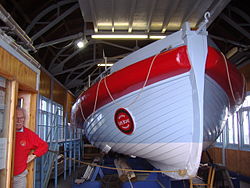RNLB Alfred Corry (ON 353)
 Alfred Corry
| |
| History | |
|---|---|
| Owner | Alfred Corry Lifeboat Museum |
| Builder | Beeching Brothers of Great Yarmouth |
| Official RNLI Number: | ON 353 |
| Donor: | |
| Station | Southwold |
| Cost | £490.7s.4d. |
| Laid down | 1893 |
| Launched | 1894 |
| Sponsored by | From the estate of Mr Alfred J Corry |
| Decommissioned | 1918 |
| In service | 25 |
| Fate | Converted to a Gentleman’s Yacht until restoration began in 1976 |
| General characteristics | |
| Class and type | Norfolk and Suffolk-Type |
| Type | Non-self-righting, sailing and rowing lifeboat |
| Tonnage | Displacement of 8 tons |
| Length | 44 ft 1 in (13.44 m) overall |
| Beam | 13 ft 0 in (3.96 m) |
| Draught | 2 ft 3.5 in (0.699 m) |
| Depth | 4 ft 10 in (1.47 m) |
| Installed power | Sail and Oars |
| Crew | 18 men |
RNLB Alfred Corry (ON 353) is a Norfolk and Suffolk-class, non-self-righting, sailing and rowing lifeboat which served in the town of Southwold in the county of Suffolk.[1][2] She is kept on display in a museum in Southwold.[3][4]
History
The Alfred Corry was constructed in 1893 by Beeching Brothers [5] of Great Yarmouth for the RNLI at a cost of £490.7s.4d.[2]
The Alfred Corry was the first example of an improved class of Norfolk and Suffolk lifeboat called the Carvel-class.[1] The finance for the building of the boat came from a donation left to the RNLI from the estate of Mr Alfred James Corry of Putney.[2] She was launched 41 times and during her 25 year working career she, and her crew, are crediited with saving 47 lives .[1]
In 1919 the Alfred Corry was sold to Lord Albermarle and converted to a yacht, based out of Lowestoft. She was renamed Alba and an engine was added in 1921.[1] In 1949 the boat was renamed Thorfinn. She was being used as a houseboat at Maldon by 1976, at which point she was bought by the great-grandson of the first coxswain and restored as a seaworthy yacht under her original name.[1] In 1994 the Alfred Corry was presented by the owner to the newly-formed Alfred Corry Charitable Trust, and restoration to her original state was due to begin at Lowestoft. However, it was decided in 1996 to return the as-yet unrestored vessel to Southwold by road. Meanwhile, the Trust had obtained the former Cromer Lifeboat shed and transported this to Southwold and, in 1998, the lifeboat was moved to her new quarters for an extensive restoration to begin.
Namesake
Alfred James Corry was born in Kensington in 1858 and was the son of a wealthy copper merchant who came from Dublin.[6] Alfred was educated in Edgebaston Oratory School and later studied Engineering. He began his career as a civil engineer with the Vauxhall Water Company. In 1883 he became a member of the Institution of Civil Engineers. In 1885 he also became a member of the Royal Institution of Naval Architects. He died at the young age of 34 in the family home in Wandsworth.[6] His last will and testament included a legacy of £15,000 to the RNLI for the "building, fitting out and equipping of one lifeboat",[6] although he did not specify any instruction as to where the lifeboat was to be based. Although Alfred Corry had no connection with the sea as such, the Cork lifeboat had once saved his parents and this is what may have prompted his legacy.
Description
The lifeboat is 44.07 feet (13.43 m) in length and has a beam of 13.00 feet (3.96 m). Her depth was 4.82 feet (1.47 m). The lifeboat is equipped with two masts carrying lug sails and she had 16 oars.[1][2]
The lifeboat was launched from the beach until 1908 when a slipway was built in the harbour. The lifeboat would be boarded before the launch. The beach team would then haul the boat by hauling on a line that was fastened around a piling on the beach.[1]
Museum
The Alfred Corry is housed in a museum named after the boat on the northern side of Southwold Harbour at the mouth of the River Blyth. The current Southwold Lifeboat Station is adjacent to the museum. The museum was once the Cromer Lifeboat shed, built in 1923 and the first of its type to have been built by the RNLI.[1] The old station was delivered to Southwold by sea in 1998 and was also fully restored. It is one of only a few remaining examples of its type lifeboat sheds built by the RNLI at that time. Alfred Corry forms the main exhibit in the museum which is free to enter.[3][4]
References
- ^ a b c d e f g h "The Alfred Corry". The National Historic Ships Website. National Historic Ships UK. Retrieved 25 August 2013.
- ^ a b c d The Alfred Corry Archived 3 March 2016 at the Wayback Machine, The Alfred Corry Museum. Retrieved 2015-11-16.
- ^ a b The Alfred Corry Lifeboat Museum. Retrieved 2015-11-16.
- ^ a b "The Alfred Corry Lifeboat Museum". Current details about Museum. Maritime Heritage East. Retrieved 26 August 2013.
- ^ "Builders – Beeching Brothers of Great Yarmouth". The National Historic Ships Website. National Historic Ships UK. Retrieved 25 August 2013.
- ^ a b c Source: The Last Will and Testament of Alfred James Corry – Death Certificate of A J Corry: Research: Mrs Mary Trumpress, on behalf of the Museum Trust: Information freely available from the Museum
